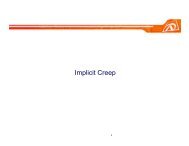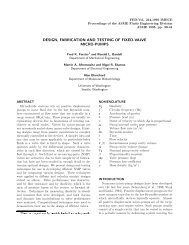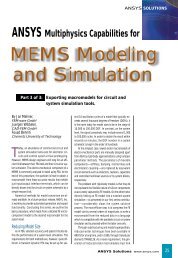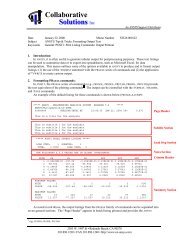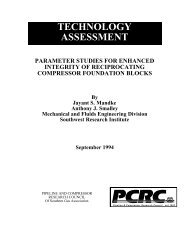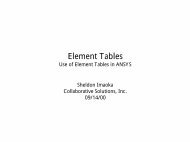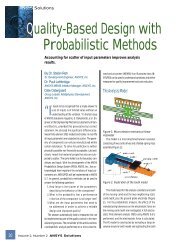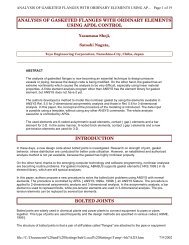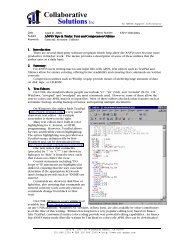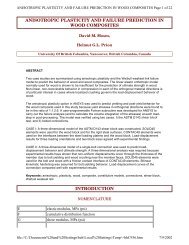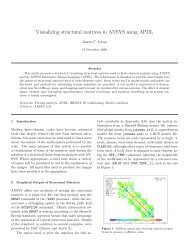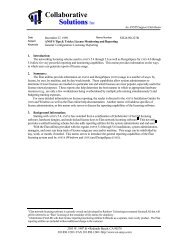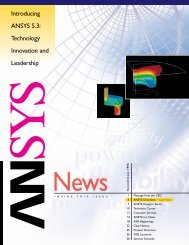Pyramid elements for maintaining tetrahedra to - ANSYS Users
Pyramid elements for maintaining tetrahedra to - ANSYS Users
Pyramid elements for maintaining tetrahedra to - ANSYS Users
Create successful ePaper yourself
Turn your PDF publications into a flip-book with our unique Google optimized e-Paper software.
ABSTRACT<br />
A method is proposed whereby an existing non-con<strong>for</strong>ming,<br />
mixed hexahedra-<strong>tetrahedra</strong> element mesh, is altered <strong>to</strong> con<strong>for</strong>m by<br />
the insertion and <strong>for</strong>mation of five-node or thirteen-node pyramids.<br />
Local <strong>tetrahedra</strong>l trans<strong>for</strong>mations are per<strong>for</strong>med <strong>to</strong> provide the<br />
<strong>to</strong>pology enabling the merging of two adjacent <strong>tetrahedra</strong> in<strong>to</strong> one<br />
pyramid. Local smoothing and cleanup operations improve the quality<br />
of the transition region. Other methods <strong>for</strong> the creation of transition<br />
pyramid <strong>elements</strong> are also discussed. Results show superior<br />
per<strong>for</strong>mance of the resulting <strong>elements</strong> in a commercial finite element<br />
code over non-con<strong>for</strong>ming interface conditions.<br />
INTRODUCTION<br />
While many au<strong>to</strong>mated <strong>tetrahedra</strong> methods have now become<br />
commonplace in the industry, all-hexahedra free meshing methods<br />
have proven <strong>to</strong> be challenging research <strong>to</strong>pics (Blacker, 1993; Price,<br />
1995; Schneiders, 1996; Tautges, 1996). Some engineering<br />
disciplines have shown a preference <strong>for</strong> hexahedral <strong>elements</strong> over<br />
<strong>tetrahedra</strong> (Cifuentes, 1992; Benzley, 1995). While all-hexahedral<br />
element meshes may be preferred, some <strong>tetrahedra</strong> <strong>elements</strong> may be<br />
acceptable within the same model. For example, blocky or easily<br />
mapped regions of the solid may be first filled with hexahedra.<br />
Regions that may be more critical <strong>to</strong> the analysis, such as boundary<br />
layers or regions of high stress may also be better served by<br />
hexahedra. Tetrahedra <strong>elements</strong> may fill the remaining, more<br />
geometrically complex, or less critical regions of the solid. Since,<br />
geometrically, two <strong>tetrahedra</strong> faces are required <strong>to</strong> interface with a<br />
single hexahedron, discontinuities will arise at the boundary between<br />
the two element types. Traditional uses of the finite element method<br />
require that <strong>elements</strong> con<strong>for</strong>m. In two-dimensions, this principle<br />
implies that no single element edge will have more than two <strong>elements</strong><br />
adjacent. In three-dimensions, no single face will have more than two<br />
adjacent <strong>elements</strong>. Edge a-b and Face c-d-e-f in Figure 1 have more<br />
PYRAMID ELEMENTS FOR MAINTAINING<br />
TETRAHEDRA TO HEXAHEDRA CONFORMABILITY<br />
Steven J. Owen, Scott A. Canann and Sunil Saigal<br />
Department of Civil and Environmental Engineering, Carnegie Mellon University<br />
and<br />
<strong>ANSYS</strong> Inc.<br />
275 Technology Drive. Cannonsburg PA. USA 15317<br />
steve.owen@ansys.com<br />
than the maximum two adjacent <strong>elements</strong>, thus rendering the mesh<br />
mathematically deficient <strong>for</strong> finite element analysis. This paper<br />
presents several solutions <strong>to</strong> the problem of non-con<strong>for</strong>ming meshes<br />
that contain <strong>tetrahedra</strong> and hexahedra <strong>elements</strong>.<br />
a<br />
b<br />
c<br />
f g<br />
Figure 1 Two and three-dimensional non-con<strong>for</strong>ming<br />
meshes<br />
ALTERNATE METHODS<br />
Dewhirst (1993, 1995) explores several possible alternatives <strong>for</strong><br />
interfacing hexahedral <strong>elements</strong> directly with <strong>tetrahedra</strong>. While<br />
recognizing that displacement discontinuities will arise at the<br />
diagonal edge (Edge c-e in Figure 1), an attempt is made <strong>to</strong> minimize<br />
the error. When ten-node <strong>tetrahedra</strong> are used, the mid-diagonal node<br />
(g) can be constrained <strong>to</strong> displace as a function of the four<br />
surrounding corner nodes by means of multi-point constraints<br />
(MPC’s). To constrain the mid-node, the solution of four non-linear<br />
simultaneous equations is required. Bretl (1984) discusses the<br />
<strong>for</strong>mulation of the MPC equations. While an improvement in results<br />
over unconstrained mid-nodes is noted, the computational expense in<br />
regions where MPC’s are defined can be severe.<br />
e<br />
d
Interfacing directly with four-node <strong>tetrahedra</strong> was also proposed.<br />
While acceptable error was reported (Dewhirst, 1993) in a limited<br />
number of test cases, it is well documented (Cifuentes, 1992; Benzley<br />
1995) that four-node <strong>tetrahedra</strong> tend <strong>to</strong> be overly stiff, per<strong>for</strong>ming<br />
poorly in structural applications.<br />
An additional alternative is <strong>to</strong> simply drop the mid-diagonal node<br />
on the ten-node tetrahedron. While some commercial finite element<br />
applications will allow dropped mid-side nodes, significant error can<br />
be introduced at the discontinuity.<br />
The <strong>ANSYS</strong> (Kohnke, 1996) finite element code also provides a<br />
general purpose alternative similar <strong>to</strong> MPCs. Interface constraint<br />
equations can be defined on the model where nodes do not match<br />
with nodes of adjacent <strong>elements</strong>. This procedure is typically used <strong>for</strong><br />
interfacing coarse element meshes with finer meshes, but can be used<br />
<strong>to</strong> constrain the mid-diagonal node between a tetrahedron and<br />
hexahedron. While some reduction in error across the interface is<br />
achieved, con<strong>for</strong>mability is nevertheless violated. The error can be<br />
reduced as the mesh is refined.<br />
While these methods <strong>for</strong> interfacing hexahedra <strong>to</strong> <strong>tetrahedra</strong> show<br />
some merit, it should be noted that most require modification of the<br />
finite element code <strong>to</strong> handle these special cases. Even when options<br />
have been provided in an existing finite element code <strong>to</strong> handle<br />
discontinuities, it is not unusual <strong>to</strong> require significant user interaction<br />
<strong>to</strong> specify appropriate conditions at the interface nodes. As a result,<br />
this research was conducted in order <strong>to</strong> develop an au<strong>to</strong>matic method<br />
<strong>for</strong> interfacing the two element types without the need <strong>for</strong> complex<br />
constraint equations or modifying an existing finite element code.<br />
Au<strong>to</strong>matic <strong>for</strong>mation of pyramid <strong>elements</strong> at the interface between<br />
hexahedra and <strong>tetrahedra</strong> appears <strong>to</strong> be a promising solution.<br />
PYRAMID ELEMENT<br />
The pyramid element has become a staple of most commercial<br />
finite element codes. Typically both five-node and thirteen-node<br />
variations are provided. Kohnke (1996) provides a development of<br />
the shape functions <strong>for</strong> both the five-node and thirteen node<br />
variations. When an explicit pyramid element <strong>for</strong>mulation is lacking,<br />
some codes will allow the pyramid element in the <strong>for</strong>m of a<br />
degenerate hexahedron. This requires one face of the hexahedron <strong>to</strong><br />
collapse <strong>to</strong> a single node. Figure 2 shows the basic 20-node<br />
hexahedron element as it is defined in <strong>ANSYS</strong>, along with its<br />
degenerate 13-node instance of a pyramid. The eight nodes on the<br />
<strong>to</strong>p face have been collapsed in<strong>to</strong> a single node.<br />
The pyramid element has been used <strong>for</strong> many years in commercial<br />
finite element codes and has proven <strong>to</strong> be reliable. Even in its<br />
degenerate hexahedral <strong>for</strong>m, the pyramid provides reliable results.<br />
As part of this study, results from an all-pyramid mesh were<br />
compared with all-<strong>tetrahedra</strong> and all-hexahedra meshes under<br />
uniaxial tension and bending. Results indicated (Table 2, near end of<br />
paper) that <strong>for</strong> uniaxial tension, similar <strong>to</strong> <strong>tetrahedra</strong> and hexahedra,<br />
pyramids can reproduce analytical results exactly. Bending results<br />
showed that quadratic, 13-node pyramids per<strong>for</strong>med reasonably well,<br />
equivalent <strong>to</strong> results from 10-node <strong>tetrahedra</strong>. While poor results<br />
were exhibited by linear pyramids under bending conditions, these<br />
results were consistent with those of linear <strong>tetrahedra</strong> under similar<br />
loading conditions.<br />
M<br />
Y<br />
I<br />
X<br />
T<br />
U<br />
Q<br />
L<br />
P<br />
B<br />
Z<br />
N<br />
J<br />
W<br />
S<br />
V<br />
R<br />
A<br />
O<br />
K<br />
I<br />
M,N,O,P,U,V,W,X<br />
Figure 2. 20-node hex and its 13-node degenerate instance<br />
of a pyramid<br />
PYRAMID MESHING<br />
Three principle methods are presented <strong>for</strong> insertion of pyramid<br />
shaped <strong>elements</strong> in an existing mixed element mesh at the interface<br />
between hexahedra and <strong>tetrahedra</strong>. The first method involves<br />
modifying the hexahedra, while <strong>maintaining</strong> the <strong>tetrahedra</strong>l <strong>elements</strong><br />
unchanged. The other methods propose trans<strong>for</strong>mations <strong>to</strong> the<br />
<strong>tetrahedra</strong> while <strong>maintaining</strong> the hexahedral <strong>elements</strong>.<br />
Hexahedral Node Insertion<br />
One option <strong>for</strong> defining compatible interfaces between hexahedra<br />
and <strong>tetrahedra</strong> is <strong>to</strong> simply insert an additional node at the centroid of<br />
all hexahedra immediately adjacent <strong>to</strong> a tetrahedron. This process<br />
involves splitting the hexahedron in<strong>to</strong> seven <strong>elements</strong>; two <strong>tetrahedra</strong><br />
and five pyramids. Figure 3 shows the results of this process when<br />
two <strong>tetrahedra</strong> are adjacent at one face of the hexahedra. If <strong>tetrahedra</strong><br />
are adjacent at additional faces of a hexahedron, additional pyramids<br />
are split.<br />
Figure 3. Exploded view of pyramid transitions defined<br />
within first layer of hexahedra. Tetrahedra (not shown)<br />
meet at triangle faces<br />
While this method is relatively simple, and tends <strong>to</strong> produce<br />
reasonable quality <strong>elements</strong>, there are some drawbacks. It is usually<br />
the hexahedra in which the user has taken additional ef<strong>for</strong>t <strong>to</strong> place<br />
within the model. Unless the <strong>elements</strong> are sufficiently fine that<br />
Y<br />
T<br />
Q<br />
L<br />
B<br />
Z<br />
J<br />
S<br />
A<br />
R<br />
K
emoval of some of the interface hexahedral <strong>elements</strong> will cause little<br />
difference, most would tend <strong>to</strong> object <strong>to</strong> the modification of this one<br />
layer. For this reason, and other application specific issues, this<br />
method was not pursued.<br />
<strong>Pyramid</strong> Open Method<br />
Another method, implemented as part of this study, was <strong>to</strong> open a<br />
pyramid from the quad face of a hexahedron. The base of the<br />
pyramid is <strong>for</strong>med from the quad face, and the triangle faces of the<br />
pyramid, from the <strong>tetrahedra</strong>.<br />
N 3<br />
N 4<br />
A<br />
C<br />
B<br />
N 2<br />
N 3<br />
N1N4 (a) (b)<br />
Figure 4. The pyramid open method<br />
Figure 4 illustrates this method. Initially , a node (C) is created<br />
at the midpoint of the diagonal edge A-B. All <strong>tetrahedra</strong> sharing an<br />
edge with A-B are then split. This is accomplished by traversing<br />
around edge A-B and splitting each adjacent face. For example, in<br />
Figure 4, the tetrahedron initially defined by nodes A-B-N1-N2<br />
becomes two <strong>tetrahedra</strong> defined by C-B-N1-N2 and A-C-N1-N2. A<br />
new pyramid element can then be <strong>for</strong>med from the nodes A-Nn-B-N1-<br />
C. The pyramid can be opened, by per<strong>for</strong>ming a constrained<br />
Laplacian smooth on node C, shown in Figure 4(b). The new location<br />
of C is defined as:<br />
A+ B+ Ni C =<br />
= 1<br />
n + 2<br />
where n is the initial number of faces adjacent <strong>to</strong> edge A-B, and Ni<br />
are nodes at opposite ends of edges from node C. Node C is also<br />
constrained <strong>to</strong> ensure <strong>tetrahedra</strong> will not become inverted. All<br />
adjacent <strong>tetrahedra</strong> are checked <strong>to</strong> ensure a minimum element shape<br />
metric (described later). If any tetrahedron fails, a new location <strong>for</strong><br />
the node is computed by taking a weighted average of its initial<br />
location and the location last computed. This process continues until<br />
valid <strong>tetrahedra</strong> and pyramid are defined.<br />
An additional case may arise if, as a result of previous insertion<br />
of pyramid <strong>elements</strong>, edge A-B is adjacent <strong>to</strong> an existing pyramid<br />
element, as shown in Figure 5(a). In this case, a pyramid (N1-N2-N3-<br />
A-B) has previously been inserted in order <strong>to</strong> maintain transitions <strong>to</strong><br />
an adjacent hexahedron. This case will arise only if the <strong>tetrahedra</strong>l<br />
trans<strong>for</strong>mation method, described later, is employed in conjunction<br />
with the pyramid open method. Consequently, it is necessary <strong>to</strong> split<br />
∑ i<br />
n<br />
A<br />
C<br />
B<br />
N 2<br />
N 1<br />
the pyramid, as shown in Figure 5(b) in<strong>to</strong> three <strong>elements</strong>: two<br />
<strong>tetrahedra</strong> (C-N1-B-N2, C-N2-B-N3) and one pyramid (N1-N2-N3-A-C).<br />
Doing so, maintains the quad base of the existing pyramid, while<br />
providing the <strong>to</strong>pology enabling the insertion of a new pyramid.<br />
N 4<br />
N 5<br />
A<br />
C<br />
N 3<br />
B<br />
N 2<br />
N 1<br />
A<br />
C<br />
N 3<br />
(a) (b)<br />
Figure 5. Splitting of existing pyramid <strong>to</strong> enable pyramid<br />
open<br />
The pyramid open method is robust and relatively simple <strong>to</strong><br />
implement. It is rare that local geometry or <strong>to</strong>pology will prohibit<br />
the algorithm from succeeding. In spite of its robustness, element<br />
qualities <strong>for</strong> <strong>tetrahedra</strong> adjacent <strong>to</strong> the pyramids tend <strong>to</strong> be lower.<br />
While clean up and smoothing can improve qualities dramatically, the<br />
<strong>tetrahedra</strong>l trans<strong>for</strong>mation method, described next, tends <strong>to</strong> give<br />
higher quality and fewer numbers of <strong>elements</strong>.<br />
Tetrahedral Trans<strong>for</strong>mation<br />
The <strong>tetrahedra</strong>l trans<strong>for</strong>mation method involves merging two<br />
adjacent <strong>tetrahedra</strong> <strong>to</strong> <strong>for</strong>m a single pyramid element. The two<br />
<strong>tetrahedra</strong> whose faces <strong>for</strong>m the triangles of the quad face of the<br />
adjacent hexahedron are the candidates <strong>for</strong> merging. Since it is likely<br />
that these two <strong>tetrahedra</strong> will not share a common face, it is necessary<br />
<strong>to</strong> per<strong>for</strong>m two-three swaps.<br />
a<br />
e d<br />
c<br />
b<br />
Figure 6 Two-three <strong>tetrahedra</strong>l swap<br />
The two-three swap is a basic trans<strong>for</strong>mation that defines three<br />
<strong>tetrahedra</strong> from what was initially two adjacent <strong>tetrahedra</strong>. The<br />
process is illustrated in Figure 6. A set of five vertices abcde,<br />
initially defining two <strong>tetrahedra</strong> abcd and acbe are trans<strong>for</strong>med <strong>to</strong><br />
define the three <strong>tetrahedra</strong> aebd, becd and cead. Any number of two-<br />
e<br />
c<br />
a<br />
B<br />
b<br />
N 2<br />
N 1<br />
d
three swaps may be per<strong>for</strong>med until the <strong>to</strong>pology is sufficient <strong>for</strong> the<br />
merging of two <strong>tetrahedra</strong> <strong>to</strong> <strong>for</strong>m a pyramid. The necessary<br />
condition <strong>for</strong> this <strong>to</strong> occur is <strong>for</strong> the diagonal edge (edge A-B in<br />
Figure 4) <strong>to</strong> have exactly two adjacent <strong>tetrahedra</strong> or exactly three<br />
adjacent triangle faces.<br />
The order in which swaps are per<strong>for</strong>med may also affect the final<br />
quality of the pyramid and its neighboring <strong>tetrahedra</strong>. In order <strong>to</strong><br />
locally improve the quality of the <strong>elements</strong>, the order of swapping is<br />
dictated by the maximum potential element quality of the resulting<br />
<strong>elements</strong>. Figure 7 provides an example of how this is done.<br />
N4<br />
N 3<br />
N 2<br />
N5 A,B N N<br />
1<br />
5 A,B N1<br />
N 4<br />
N 3<br />
N5 A,B N N 1<br />
5 A,B N1<br />
N 4<br />
N 3<br />
(a) (b)<br />
N 3<br />
(c) (d)<br />
Figure 7 Local <strong>tetrahedra</strong>l trans<strong>for</strong>mations <strong>to</strong> define<br />
pyramid<br />
To simplify visualization, Figure 7(a) shows a “<strong>to</strong>p” view of the<br />
quadrilateral diagonal edge A-B (side view of the quadrilateral). The<br />
quadrilateral face in this case is defined by nodes A-N1-B-N5. There<br />
are initially four <strong>tetrahedra</strong> adjacent <strong>to</strong> edge A-B. The objective is <strong>to</strong><br />
reduce this number <strong>to</strong> two. The dotted lines in (b) show the three<br />
possible two-three swaps which can be per<strong>for</strong>med. To select<br />
potential two-three swap trans<strong>for</strong>mation pairs, each pair of <strong>tetrahedra</strong><br />
adjacent <strong>to</strong> a face sharing edge A-B is tested. A shape metric <strong>for</strong> each<br />
of the three potential <strong>tetrahedra</strong> <strong>to</strong> be <strong>for</strong>med as a result of a twothree<br />
swap is computed and summed. If a potential tetrahedron has a<br />
negative shape metric (the tetrahedron is inverted), the potential swap<br />
is immediately discarded as an option. The five-node set defined by<br />
nodes A-B-N2-N3-N4 in (b) shows a case where a negative shape<br />
metric would result if a two-three swap was per<strong>for</strong>med . The<br />
maximum value <strong>for</strong> the sum of the metrics <strong>for</strong> the potential <strong>tetrahedra</strong><br />
is used <strong>to</strong> indicate which trans<strong>for</strong>mation will be per<strong>for</strong>med. In this<br />
case, the <strong>tetrahedra</strong> A-B-N1-N2 and A-N2-B-N3 were trans<strong>for</strong>med in<strong>to</strong><br />
A-N3-B-N2, B-N3-N1-N2 and N1-N3-A-N2. As a result of the swap,<br />
only one of the three resulting <strong>tetrahedra</strong> is now adjacent <strong>to</strong> edge A-<br />
B, reducing the <strong>to</strong>tal number of <strong>tetrahedra</strong> adjacent <strong>to</strong> edge A-B by<br />
one (shown in (c)). This process is once again per<strong>for</strong>med. Figure 7<br />
(c) shows two potential trans<strong>for</strong>mations which could be per<strong>for</strong>med.<br />
The two-three swap resulting in the highest quality <strong>elements</strong> is<br />
effected resulting in the configuration in (d). At this point, the<br />
necessary conditions <strong>for</strong> the <strong>for</strong>mation of a pyramid are satisfied. The<br />
N 2<br />
two <strong>tetrahedra</strong> A-B-N1-N3 and A-N5-B-N3 are merged <strong>to</strong> <strong>for</strong>m the<br />
pyramid A-N1-B-N5-N3.<br />
It should be noted that geometric configurations of <strong>tetrahedra</strong><br />
adjacent <strong>to</strong> edge A-B may not allow any two-three swaps <strong>to</strong> occur.<br />
This occurs when all potential trans<strong>for</strong>mations result in at least one<br />
inverted tetrahedron. To avoid such a case, while infrequent, the<br />
pyramid open method is reverted <strong>to</strong> when geometric conditions do not<br />
allow local trans<strong>for</strong>mations.<br />
The shape metric, Q, used <strong>to</strong> determine the order of<br />
trans<strong>for</strong>mations, is the inscribed <strong>to</strong> circumscribed sphere ratio of the<br />
tetrahedron,<br />
Q<br />
r<br />
= 3<br />
R<br />
where r is the inscribed sphere radius and R is the circumscribed<br />
sphere radius. Joe (1995) presents a closed <strong>for</strong>m expression of the<br />
metric in terms of the tetrahedron’s node locations. This measure<br />
provides a maximum value of 1.0 <strong>for</strong> a regular tetrahedron. If the<br />
volume of the tetrahedron is less than zero, (the element is inverted),<br />
the metric is modified <strong>to</strong> return a negative value.<br />
Figure 8 shows the results of <strong>for</strong>ming pyramids from <strong>tetrahedra</strong>l<br />
trans<strong>for</strong>mations. Of the 25 pyramids <strong>for</strong>med in this example, two<br />
conditions existed in which local trans<strong>for</strong>mations could not be used.<br />
As a result, the pyramid open method was au<strong>to</strong>matically invoked.<br />
Table 1 displays minimum and average shape metrics <strong>for</strong> pyramids<br />
and <strong>tetrahedra</strong> <strong>for</strong> the model shown in Figure 8.<br />
Figure 8. Exploded view of pyramids <strong>for</strong>med using<br />
<strong>tetrahedra</strong>l trans<strong>for</strong>mations. Hexahedra (not shown)<br />
adjacent <strong>to</strong> quad faces.<br />
CLEAN UP<br />
While the methods presented do not allow the <strong>for</strong>mation of<br />
inverted <strong>elements</strong>, the quality of the pyramids and <strong>tetrahedra</strong> may be<br />
lacking. In order <strong>to</strong> improve local quality of <strong>elements</strong> in the<br />
transition region after trans<strong>for</strong>mations have been per<strong>for</strong>med, both<br />
smoothing and <strong>to</strong>pological cleanup is done.<br />
Smoothing<br />
Constrained Laplacian smoothing is done locally within the<br />
transition region. To accomplish this, a local search is done
eginning with nodes on the interface between the hexahedra and<br />
<strong>tetrahedra</strong>. Nodes within the volume that are <strong>to</strong>pologically within<br />
three edges are marked <strong>to</strong> be smoothed. Laplacian smoothing<br />
involves repositioning nodes <strong>to</strong> reside at the centroid of its<br />
surrounding nodes connected by an edge. Since this technique can<br />
sometimes decrease the element quality and even invert otherwise<br />
reasonable <strong>elements</strong>, the decision <strong>to</strong> move the node is based on<br />
whether the minimum shape metric of the node’s surrounding<br />
<strong>elements</strong> is improved. If no improvement can be made, the node<br />
remains at its original location.<br />
Since the constrained Laplacian smoothing operation depends on<br />
the definition of a shape metric, it was necessary <strong>to</strong> define a shape<br />
metric <strong>for</strong> the pyramid element. While the inscribed <strong>to</strong> circumscribed<br />
sphere ratio can be used <strong>for</strong> <strong>tetrahedra</strong>, it can not be directly used <strong>for</strong><br />
pyramids. The solution was <strong>to</strong> compute four shape metrics of the<br />
<strong>tetrahedra</strong> that can be derived from the pyramid, as shown in Figure<br />
9. The minimum radius ratio of the four is used as the metric.<br />
a<br />
Figure 9. Division of a pyramid in<strong>to</strong> four <strong>tetrahedra</strong> <strong>for</strong><br />
pyramid shape metric<br />
d<br />
1.0<br />
e<br />
Figure 10. Iso-values <strong>for</strong> pyramid shape metric<br />
b<br />
0.9<br />
0.8<br />
0.7<br />
0.6<br />
0.5<br />
0.4<br />
0.3<br />
0.2<br />
0.1<br />
c<br />
The metric is also normalized by a constant, α, where α was<br />
experimentally determined <strong>to</strong> be approximately 0.86034. α was<br />
defined by computing the maximum shape metric <strong>for</strong> one of the four<br />
<strong>tetrahedra</strong> where the apex node is constrained <strong>to</strong> lie on a line normal<br />
<strong>to</strong> the base passing through its centroid. This metric defines an ideal<br />
pyramid having a base defined as a perfect square ,length b, with<br />
apex node at height h=0.98154b . As a result, an ideal pyramid will<br />
have a shape metric of 1.0. In this way, metrics <strong>for</strong> pyramids can be<br />
directly compared and summed with those of <strong>tetrahedra</strong> <strong>to</strong> be used in<br />
the smoothing algorithm.<br />
Figure 10 displays a three dimensional view of the shape metric<br />
<strong>for</strong> the pyramid element. While the base of the pyramid, defined by<br />
nodes a-b-c-d, remains constant, the apex, node e, is moved. Figure<br />
10 was defined by moving node e <strong>to</strong> locations of a regular grid and<br />
computing the resulting shape metric <strong>for</strong> the pyramid. Since the<br />
resulting function is symmetric about the X and Y axis, only ¼ of the<br />
domain was computed. The surfaces represent the iso-values <strong>for</strong> the<br />
shape metric function at 0.1 intervals.<br />
Topological Improvement<br />
The ability <strong>to</strong> swap faces <strong>to</strong> improve <strong>tetrahedra</strong> shape metrics is<br />
also used as a means of improving the element quality in the<br />
transition region. The basis <strong>for</strong> <strong>tetrahedra</strong> improvement used in this<br />
study can be found in Joe (1995). Essentially, local permutations of<br />
connectivities are examined in order <strong>to</strong> find improvement in overall<br />
shape metric. Local trans<strong>for</strong>mations are per<strong>for</strong>med on the existing<br />
<strong>tetrahedra</strong> by flipping faces <strong>to</strong> achieve this improvement. Of the<br />
trans<strong>for</strong>mations described by Joe, the T23, T32 and T44 flips were<br />
used. No changes were made <strong>to</strong> pyramids or <strong>to</strong> the boundary of the<br />
mesh.<br />
Table 1. Comparison of element shape metrics after cleanup<br />
operations per<strong>for</strong>med.<br />
Initial <strong>Pyramid</strong>s<br />
inserted<br />
Smooth Topological<br />
Improve<br />
-ment<br />
Final<br />
smooth<br />
Tet Num 660 627 627 623 623<br />
Min .586944 .000016 .184845 .407329 .414901<br />
Avg .814500 .806665 .825427 .826503 .835560<br />
Pyr Num 0 25 25 25 25<br />
Min N/A .799915 .757268 .757268 .769436<br />
Avg N/A .835968 .822949 .822949 .833507<br />
From trial and error it was found that an initial smoothing<br />
iteration followed by <strong>to</strong>pological improvement followed by additional<br />
iterations of smoothing appeared <strong>to</strong> provide significant improvement,<br />
yet remain fairly cost effective. Table 1 lists the element shape<br />
metrics <strong>for</strong> both <strong>tetrahedra</strong> and pyramids after each step of the cleanup<br />
operation <strong>for</strong> the model shown in Figure 8. The number of each<br />
element type as well as the minimum and average shape metric <strong>for</strong><br />
the element type are shown. After pyramids have been inserted, and
without any <strong>to</strong>pological improvement, <strong>tetrahedra</strong> are of unacceptable<br />
quality. A minimum <strong>tetrahedra</strong> shape metric of approximately 0.1 is<br />
generally considered acceptable. After smoothing and <strong>to</strong>pological<br />
improvement, the element shape metrics are easily satisfac<strong>to</strong>ry <strong>for</strong><br />
finite element analysis.<br />
Figure 11. Finite element model used <strong>for</strong> tests<br />
Figure 12. Exploded view of pyramids at the interface.<br />
Tetrahedra have been removed.<br />
TEST CASES<br />
Several tests were run, in order <strong>to</strong> determine the effect of various<br />
interface conditions on the analysis results. The latest version of the<br />
<strong>ANSYS</strong> finite element code was used <strong>for</strong> analysis. A simple block<br />
divided by an arbitrary cutting plane, as shown in Figure 11 was used<br />
<strong>for</strong> testing. The cutting plane served as the interface between two<br />
volumes in which hexahedra or <strong>tetrahedra</strong> <strong>elements</strong> were generated.<br />
The testing involved defining various interface conditions at the<br />
interface plane and comparing their per<strong>for</strong>mance under uniaxial<br />
tension and bending.<br />
Table 2. Comparison of FEM results under various<br />
hexahedra <strong>to</strong> <strong>tetrahedra</strong> interface conditions<br />
Elements in Model<br />
(elem shape - no. nodes per elem)<br />
Vol 1 Vol 2 Interface<br />
Condition<br />
% Error<br />
Hex-8 Hex-8 Hex-8 disp: exact<br />
stress: exact<br />
Tet-10 Tet-10 Tet-10 disp: exact<br />
stress: exact<br />
Pyr-13 Pyr-13 Pyr-13 disp: exact<br />
stress: exact<br />
Hex-20 Tet-10 Pyr-13 disp: exact<br />
stress: exact<br />
Tet-9 disp: 31.3<br />
stress: 34.1<br />
Tet-10 + CE disp: ord 10 -4<br />
Tension Bending<br />
stress: ord 10 -4<br />
Hex-8 Tet-10 Pyr-9 disp: exact<br />
stress: exact<br />
Tet-7 disp: 16.5<br />
stress: 29.3<br />
Pyr-13 + CE disp: exact<br />
stress: exact<br />
Tet-10 + CE disp: exact<br />
stress: exact<br />
Hex-8 Tet-4 Pyr-5 disp: exact<br />
stress: exact<br />
Tet-4 disp: 10.2<br />
stress: 7.02<br />
Hex-8 Tet-10 Hex-12 + Pyr-13 disp: exact<br />
stress: exact<br />
Hex-12 + Tet-9 disp: 30.5<br />
stress: 34.7<br />
stress: 0.91<br />
stress: 1.47<br />
stress: 1.77<br />
stress: 2.30<br />
stress: 28.3<br />
stress: 44.1<br />
stress: 3.88<br />
stress: 26.1<br />
stress:7.04<br />
stress: 40.0<br />
stress: 33.4<br />
stress: 33.6<br />
stress: 6.41<br />
stress: 44.7<br />
Fourteen different element configurations were tested. For the<br />
tension case, a uni<strong>for</strong>m uniaxial surface pressure was applied on<br />
opposite ends of the model. Minimal constraints were applied <strong>to</strong><br />
inhibit rotations and translations. For the bending case, uni<strong>for</strong>mly<br />
varying loads were placed on either end of the model <strong>to</strong> simulate<br />
equal and opposite moments. Table 2 displays the maximum percent<br />
error from the exact analytical solution <strong>for</strong> stress and displacement<br />
<strong>for</strong> the tension tests and stress only <strong>for</strong> the bending tests. For tension,<br />
percent error is computed from the nodal solutions on the interface
plane, while maximum percent error in bending is computed from<br />
nodes at the <strong>to</strong>p and bot<strong>to</strong>m surfaces farthest from the neutral axis.<br />
The first three conditions described in Table 2 use the same<br />
element type throughout both volumes. Exact answers, as compared<br />
<strong>to</strong> the analytic solution <strong>for</strong> axial tension, indicate that these <strong>elements</strong><br />
pass the “patch” test. A result is listed as exact, if the percent error is<br />
on the order of 10 -9 or less. In these tests, the FEA code uses a<br />
degenerate <strong>for</strong>m of a hexahedron <strong>to</strong> simulate both tetrahedron and<br />
pyramid <strong>elements</strong> <strong>for</strong> both the linear and quadratic cases. For the allpyramid<br />
case, hexahedron were first generated in both volumes and<br />
then each hexahedron subdivided in<strong>to</strong> six pyramids by placing a node<br />
at the hexahedron centroid.<br />
For the remainder of the tests either linear or quadratic hexahedra<br />
were generated in volume 1 with linear or quadratic <strong>tetrahedra</strong><br />
generated in volume 2. Interface conditions included either placing<br />
two <strong>tetrahedra</strong> directly adjacent <strong>to</strong> a single hexahedra, or using<br />
pyramids <strong>for</strong>med by <strong>tetrahedra</strong>l trans<strong>for</strong>mations or pyramid opens.<br />
Figure 12 shows an exploded view of the pyramids generated at the<br />
hexahedra-<strong>tetrahedra</strong> interface with the <strong>tetrahedra</strong> removed. Also<br />
compared are the use of constraint equations (CE) when incompatible<br />
nodes arise at the interface.<br />
In some cases it was necessary <strong>to</strong> drop midside nodes in order <strong>to</strong><br />
maintain compatibilty between linear and quadratic <strong>elements</strong>. For<br />
example, the Hex-8 and Tet-10 configuration required interfacing<br />
pyramids, (Pyr-9) with dropped midnodes. In this case, a full 13node<br />
pyramid has the four nodes of its quad base removed. The<br />
<strong>ANSYS</strong> analysis code recognizes these edges as linear and handles<br />
them appropriately. For comparison, the final two cases illustrate the<br />
Hex-8 and Tet-10 with the midnodes not dropped. A Hex-12, a linear<br />
hexahedron with four quadratic edges at the interface, is directly<br />
adjacent a full Pyr-13 or Tet-10 element.<br />
These results indicate clearly the advantage of using pyramid<br />
transition <strong>elements</strong> over other hexahedron <strong>to</strong> tetrahedron methods. In<br />
the pure tension case, pyramid <strong>elements</strong> are able <strong>to</strong> reproduce exact<br />
results <strong>for</strong> both stress and displacement. This is in direct contrast <strong>to</strong><br />
non-con<strong>for</strong>ming interface conditions where errors at the interface can<br />
be in the range of 30 percent <strong>for</strong> this model. While constraint<br />
equations appear <strong>to</strong> per<strong>for</strong>m well in tension, poor per<strong>for</strong>mance was<br />
indicated <strong>for</strong> bending.<br />
Bending results also indicate favorable per<strong>for</strong>mance of pyramid<br />
transition <strong>elements</strong>. While linear pyramids with <strong>tetrahedra</strong> per<strong>for</strong>m<br />
poorly under bending conditions, the quadratic transition pyramid is<br />
equivalent <strong>to</strong> results from all-hex and all-tet meshes with error in the<br />
range of 2 percent.<br />
CONCLUSION<br />
Several methods <strong>for</strong> interfacing <strong>tetrahedra</strong> directly with<br />
hexahedra have been presented. The <strong>for</strong>mation of pyramid shaped<br />
<strong>elements</strong> appear <strong>to</strong> be a promising alternative. <strong>Pyramid</strong>s <strong>for</strong>med from<br />
existing <strong>tetrahedra</strong> via <strong>tetrahedra</strong>l trans<strong>for</strong>mations followed by<br />
cleanup and smoothing operations result in a con<strong>for</strong>ming mesh with<br />
reasonable quality <strong>elements</strong>. Tension and bending tests indicate that<br />
pyramid transition <strong>elements</strong> are in all cases superior <strong>to</strong> non-<br />
con<strong>for</strong>ming interface conditions. <strong>Pyramid</strong> transitions were also<br />
shown <strong>to</strong> be superior <strong>to</strong> multi-point constraint methods.<br />
ACKNOWLEDGEMENTS<br />
Thanks go <strong>to</strong> <strong>ANSYS</strong> Inc. <strong>for</strong> the funding, resources and impetus<br />
<strong>for</strong> this research. Thanks also go <strong>to</strong> Justin Vegso who set up and<br />
per<strong>for</strong>med the finite element analysis tests using <strong>ANSYS</strong> Inc.<br />
software.<br />
REFERENCES<br />
Benzley, Steven E., Ernest Perry, Karl Merkley, Brett Clark and<br />
Greg Sjaardema, 1995, "A comparison of All-Hexahedral and All-<br />
Tetrahedral Finite Element Meshes <strong>for</strong> Elastic and Elas<strong>to</strong>-Plastic<br />
Analysis", Proceedings, 4th International Meshing Roundtable,<br />
Sandia National Labora<strong>to</strong>ries, Oc<strong>to</strong>ber 1995, pp.179-191.<br />
Blacker, Ted D. And Ray J. Meyers, 1993 “Seams and Wedges in<br />
Plastering: A 3-D Hexhedral Mesh Generation Algorithm.”<br />
Engineering With Computers. Vol 9, pp. 83-93<br />
Bretl, J., 1984, “Connecting Solid Finite Element Models That<br />
Have Dissimilar Meshes on the Mating Surfaces.” MSC/NASTRAN<br />
User Conference, March 23, 1984.<br />
Cifuentes, A.O. and A. Kalbag, 1992, “A Per<strong>for</strong>mance Study of<br />
Tetrahedral and Hexahedral Elements in 3-D Finite Element<br />
Structural Analysis.” Finite Elements in Analysis and Design, Vol.<br />
12, pp.313-318<br />
Dewhirst, Donald L., Sreedhar Vangavolu and Harley Wattrick,<br />
1995, “The Combination of Hexahedral and Tetrahedral Meshing<br />
Algorithms” Proceedings, 4th International Meshing Roundtable,<br />
Sandia National Labora<strong>to</strong>ries, Oc<strong>to</strong>ber 1995, pp.291-304.<br />
Dewhirst, Donald L. and Peter M. Grinsell, 1993, “Joining<br />
Tetrahedra <strong>to</strong> Hexahedra” MSC 1993 World <strong>Users</strong>’ Conference<br />
Proceedings, Arling<strong>to</strong>n, Virginia, May 24-28,1993<br />
Joe, Barry., 1995, “Construction of Three-Dimensional<br />
Improved-Quality Triangulations Using Local Trans<strong>for</strong>mations”<br />
Siam J. Sci. Comput,. Vol. 16, pp. 1292-1307.<br />
Kohnke, Peter ed., 1996, “<strong>ANSYS</strong> User’s Manual <strong>for</strong> Revision<br />
5.3”, <strong>ANSYS</strong> Inc., Hous<strong>to</strong>n PA.<br />
Price, M.A. and C.G. Armstrong, 1995, “Hexahedral Mesh<br />
Generation by Medial Surface Subdivision: Part I.” International<br />
Journal <strong>for</strong> Numerical Methods in Engineering, Vol. 38, pp. 3335-<br />
3359<br />
Tautges, Timothy J., Ted Blacker and Scott A. Mitchell, 1996,<br />
“The Whisker Weaving Algorithm: A Connectivity-Based Method <strong>for</strong><br />
Constructing All-Hexahedral Finite Element Meshes.” International<br />
Journal <strong>for</strong> Numerical Methods in Engineering, Vol. 39, pp. 3327-<br />
3349<br />
Schneiders, R., 1996, “A Grid-based Algorithm <strong>for</strong> Generation of<br />
Hexahedral Element Meshes.” Engineering With Computers, Vol .<br />
12, pp. 168-177



